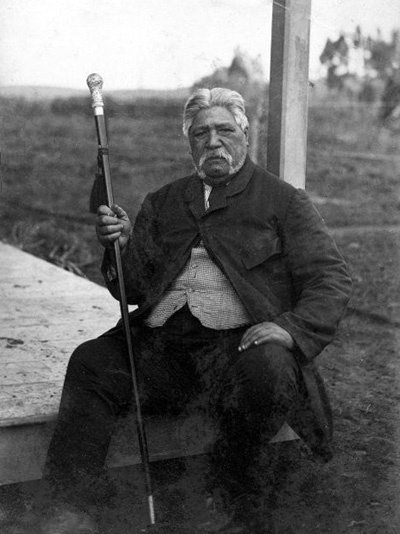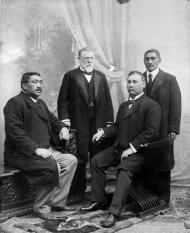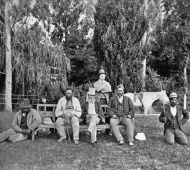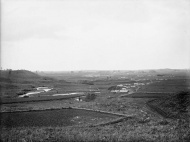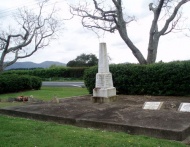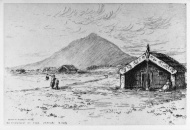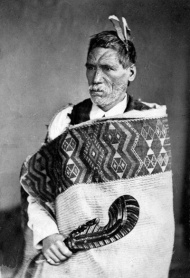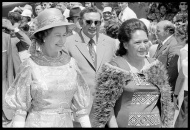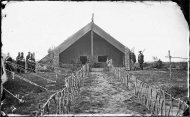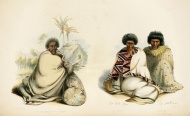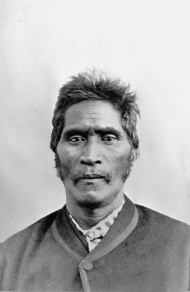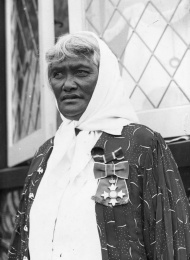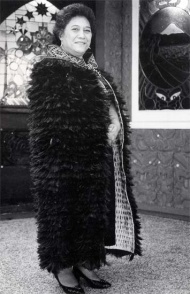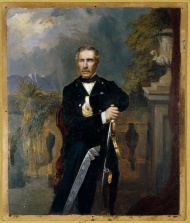Events In History
-
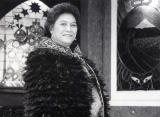 23 May 1966Coronation of first Māori Queen
23 May 1966Coronation of first Māori QueenPrincess Piki, the daughter of King Koroki, was selected as the sixth Maori monarch − and first Queen − during her father's tangi, in accordance with Kingitanga protocol. She assumed her mother’s name, Te Atairangikaahu. Read more...
-
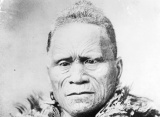 26 August 1894Death of second Māori King
26 August 1894Death of second Māori KingTāwhiao had led his people through the traumatic period during and after the wars of the 1860s. He was succeeded by his son Mahuta. Read more...
-
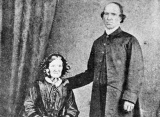 13 February 1869Killings at Pukearuhe
13 February 1869Killings at PukearuheA Ngāti Maniapoto war party sacked the redoubt at Pukearuhe (White Cliffs) in northern Taranaki, killing military settlers, family members and the missionary John Whiteley. Read more...
-
 9 June 1868Beginning of Tītokowaru's war
9 June 1868Beginning of Tītokowaru's warNgā Ruahine fighters led by Riwha Tītokowaru killed three Pākehā settlers near Ketemarae, north of Hāwera, signalling the resumption of fighting in south Taranaki. Read more...
-
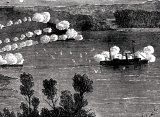 12 July 1863British forces invade Waikato
12 July 1863British forces invade WaikatoBritish troops invaded Waikato by crossing the Mangatāwhiri Stream, which the Kīngitanga (Māori King movement) had declared an aukati (a line not to be crossed). Read more...
-
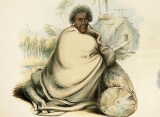 25 June 1860Death of the first Māori King
25 June 1860Death of the first Māori KingThe Māori King movement came into existence in the late 1850s as an attempt to unite the tribes, prevent land sales and make laws for Māori. Pōtatau Te Wherowhero became the first Māori King in 1858, but died two years later. Read more...
Articles
Māori King movement origins

In May 2008 Māori gathered at Ngāruawāhia to celebrate the 150th anniversary of the formation of the Kīngitanga, or Māori King Movement. The current king, Te Arikinui Tūheitia Paki, was crowned in August 2006 following the death of his mother, Dame Te Atairangikaahu.
-
Page 2 – Overview
On 23 May 2006 the Māori Queen, Te Arikinui Dame Te Atairangikaahu, celebrated the 40th jubilee of her coronation. She was the sixth Māori monarch and the longest-serving.
-
Page 3 – The land issue
Pressure to sell land was a key factor in the creation of the Kīngitanga. Before European settlement Māori had no concept of selling land and few chiefs had the authority to
-
Page 4 – In search of a king
The Kīngitanga has often been described as a Waikato initiative, yet its origins can be traced to Ōtaki on the Kāpiti Coast.
-
Page 5 – Pōtatau Te Wherowhero
In April 1857, at Rangiriri, Pōtatau agreed to become king. He was crowned and anointed at Ngāruawāhia in June 1858.
-
Page 6 – A challenge to European authority?
Pōtatau established a boundary between the territory in which his authority held sway and that of the governor: 'Let Maungatautari [River] be our boundary. Do not encroach on
-
Page 7 – Further information
This web feature was written by Steve Watters and produced by the NZHistory team.LinksThe King movement (Te Ara)Waikato (Te Ara)Mātene Te Whiwhi biography (DNZB)Pōtatau Te
Māori King movement - 1860-94
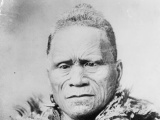
King Tāwhiao's reign was dominated by the Waikato War and the fallout from it.
-
Page 2 – Build-up to war
Like his father, King Tāwhiao had no intention of becoming involved in the war in Taranaki. The government, however, remained unconvinced of this. In July 1860 Governor Gore
-
Page 3 – Response to war
The invasion of Waikato unified the factions within the Kīngitanga, whose forces won some victories despite being at an overwhelming disadvantage in terms of manpower and
-
Page 4 – Raupatu
Under the terms of the New Zealand Settlements Act 1863 the government confiscated huge areas of Māori land in late 1864.
-
Page 5 – Maintaining Te Kīngitanga
By the early 1870s, the Kīngitanga was struggling. Living conditions within the Rohe Potae (the Māori King's territory) were poor. Allies such as Ngāti Hauā had resumed selling
-
Page 6 – Tensions ease
It was clear by the 1870s that the Kīngitanga could no longer fight a war. Attempts were made to ease relations between the king and the colonial government.
-
Page 7 – The death of Tāwhiao
Tāwhiao died on 26 August 1894. He was buried at Taupiri after a tangihanga attended by thousands.
-
Page 8 – Further information
This web feature was written by Steve Watters and produced by the NZHistory.net.nz team.LinksDonald McLean biographyGeorge Grey biographyJohn Gorst biographyRewi Maniapoto
War in Waikato
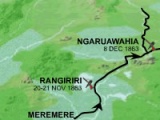
After fighting broke out again in Taranaki in early 1863, Governor George Grey turned his attention to the region he saw as the root of his problems with Māori: Waikato, the heartland of the anti-landselling King Movement. Grey vowed to ‘dig around’ the Kīngitanga until it fell.
-
Page 2 – Invasion plans
Governor Gore Browne demanded that the Kīngitanga submit ‘without reserve’ to the British Queen and began planning an invasion of Waikato shortly before his reassignment to
-
Page 6 – The Battle of Ōrākau
James Belich argues that the British victory at Ōrākau was also their ‘cruellest disappointment of the entire war’. Chris Pugsley, on the other hand, sees Ōrākau as the ‘
The Treaty in practice
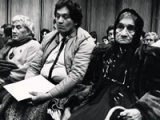
Amalgamating Māori into colonial settler society was a key part of British policy in New Zealand after 1840. Economic and social change, along with land-purchase programmes, were central to this process.
-
Page 8 – The Waikato-Tainui claim
The Waikato-Tainui people and the Crown signed a Deed of Settlement in 1995. It included a formal apology for Crown actions in the wars of the 1860s that had brought
Treaty timeline
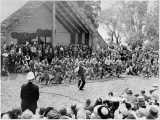
See some of the key events between 1800 and 1849 relating to the Treaty of Waitangi.
- Page 2 - Treaty events 1850-99See the key events between 1850 and 1899 relating to the Treaty of
War in Taranaki 1860-63
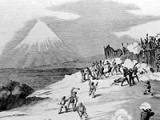
In March 1860 war broke out between Europeans and Māori in Taranaki following a dispute over the sale of land at Waitara. It was the beginning of a series of conflicts that would dog Taranaki for 21 years, claiming the lives of hundreds of people and leaving deep scars that persist to the present day.
-
Page 8 – The second Taranaki war
On 12 March 1863, 300 men of the 57th Regiment evicted Māori from the land they had occupied at Tataraimaka, 20 km south-west of New Plymouth.
Māori and the First World War
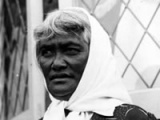
Māori reactions to serving in the First World War largely reflected iwi experiences of British actions in the 19th century.
- Page 3 - Māori objection to conscriptionMāori served in the First World War in the Maori Contingent. At home, some Māori strongly opposed
The 1920s

The 1920s was the decade that modern New Zealand came of age. Despite political and economic uncertainty, the country shrugged off the gloom of war to embrace the Jazz Age - an era of speed, power and glamour. Explore an overview of the decade and a year-by-year breakdown of key events.
- Page 4 - 1921 - key eventsA selection of key New Zealand events from
The 1960s

Five decades ago most Kiwis enjoyed a standard of living that was the envy of other nations. During the 1960s the arrival of TV and jet airliners shrank our world, and New Zealanders began to express themselves on a range of international issues, including opposition to the Vietnam War.
- Page 9 - 1966 - key eventsA selection of the key events in New Zealand history from
New Zealand's 19th-century wars
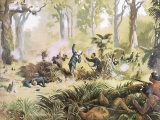
War changed the face of New Zealand in the 19th century. Many thousands of Māori died in the intertribal Musket Wars between the 1810s and the 1830s. There were more deaths during the New Zealand Wars of the 1840s to 1870s between some Māori and the Crown, which for many tribes had dire consequences.
- Page 6 - NZ Wars flagsMany Maori in the 19th century saw the Union Jack as a potent symbol of Great Britain's power in New Zealand. In the New Zealand Wars, Maori who resisted government forces often
Biographies
-
 Kaihau, Hēnare
Kaihau, Hēnare
Hēnare Kaihau become deeply interested in Māori politics, and strongly supported the King movement, becoming a principal adviser to Mahuta, the third Māori King.
Read more... -
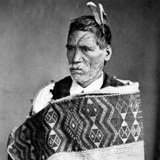 Maniapoto, Rewi Manga
Maniapoto, Rewi Manga
A famous Ngāti Maniapoto warrior, leader and supporter of the King Movement who's exploits in the Waikato War have been immortalised in book and film.
Read more... -
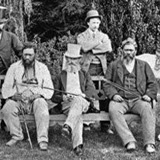 Matua, Hēnare
Matua, Hēnare
Ngāti Kahungunu chief Hēnare Matua was leader of the repudiation movement, which questioned land sales that it believed had been undertaken fraudulently.
Read more... -
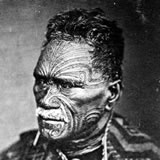 Tāwhiao, Tukaroto Potatau Matutaera
Tāwhiao, Tukaroto Potatau Matutaera
Tāwhiao's father Pōtatau was the first Māori King, and on his death in 1860 Tāwhiao inherited the kingship and the spiritual leadership of his people. He was king for the next 34 years, including the most turbulent period in New Zealand's race relations history.
Read more... -
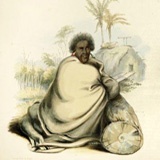 Te Wherowhero, Pōtatau
Te Wherowhero, Pōtatau
In the 1850s, a movement was set up to appoint a Māori king who would unite the tribes, protect land from further sales and make laws for Māori to follow. Te Wherowhero became the first Māori king in 1858.
Read more... -
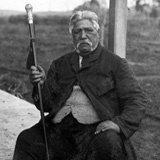 Wahanui Huatare
Wahanui Huatare
Ngāti Maniapoto leader, Wahanui Huatare, was a notable tohunga (Māori spiritual expert) and an influential chief.
Read more... -
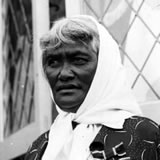 Hērangi, Te Kirihaehae Te Puea (Princess Te Puea)
Hērangi, Te Kirihaehae Te Puea (Princess Te Puea)
Te Puea Hērangi was granddaughter of the second Māori King. She was a staunch opponent of conscription for Waikato during the First World War and a prominent advocate for Tainui.
Read more... -
 Te Rata Mahuta Tāwhiao Pōtatau Te Wherowhero Korokō
Te Rata Mahuta Tāwhiao Pōtatau Te Wherowhero Korokō
The fifth Māori King, Korokī Te Rata Mahuta Tāwhiao Pōtatau Te Wherowhero struggled to maintain the dignity of the Kīngitanga and obtain recognition during his reign.
Read more... -
 Tāwhiao, Mahuta Pōtatau Te Wherowhero
Tāwhiao, Mahuta Pōtatau Te Wherowhero
Mahuta Tāwhiao, of Ngāti Mahuta was the oldest son of Tāwhiao, the second Māori King, who he succeeded in 1894.
Read more... -
 Gorst, John Eldon
Gorst, John Eldon
John Gorst was a Waikato politician who sympathised to some extent with the Kīngitanga and its political aspirations.
Read more...
Related keywords
- maori leaders
- riwha titokowaru
- race relations
- Maori MPs
- henare kaihau
- ngati te ata
- new zealand wars
- pukearuhe
- john gorst
- waikato wars
- ngati maniapoto
- wahanui huatare
- mahuta tawhiao potatau te wherowhero
- peter fraser
- king koroki
- land claims
- ngati kahungunu
- henare matua
- henry russell
- maori housing
- pai marire
- te kooti
- flags
- maori
- tukaroto potatau matutaera tawhiao
- taupiri
- potatau te wherowhero
- maps
- queen elizabeth
- turangawaewae
- royal tours
- royalty
- Rangiaowhia
- ngaruawahia
- NZ Wars memorial
- waikato
- pirongia
- te reo māori
- tainui
- rewi maniapoto
- land confiscation
- king country
- te atairangikaahu
- 1970s
- railways
- queen victoria
- taranaki
- anzac day
- 1920s
- musket wars
- declaration of independence
- george grey
- thomas gore browne
- protest
- wiremu kingi
- disasters
- vietnam war
- television
- 1960s
- painting
- george french angas
- ngati mahuta
- treaty of waitangi
- religion
- wiremu tamihana tarapipipi te waharoa
- maori land
- ngati haua
- te puea herangi
- conscientious objection
- tuheitia paki
- conscription
- treaty of waikato
- orakau
- WW1
- maori in war
- rua kenana
- maori contingent
- governor
- northern war
- timeline
- parihaka attack
- maori land court
-
Main image: Wahanui Huatare
Portrait of Wahanui Huatare seated on the verandah of his house in Alexandra, 1885. He holds a staff in one hand. Taken by the Burton Brothers.

